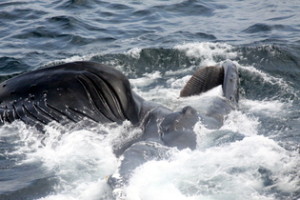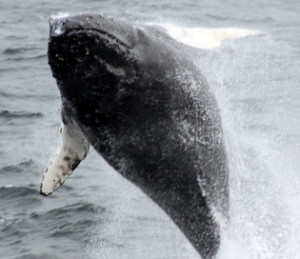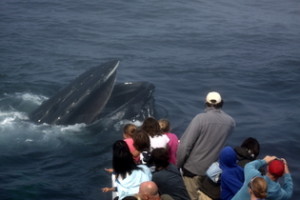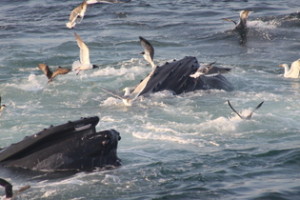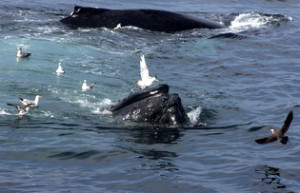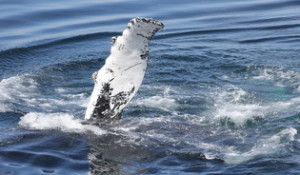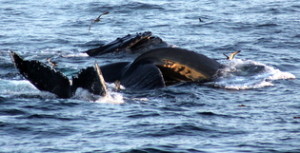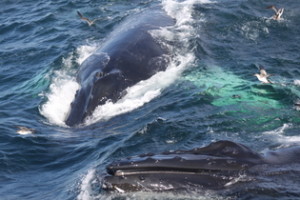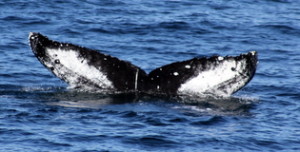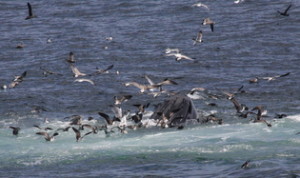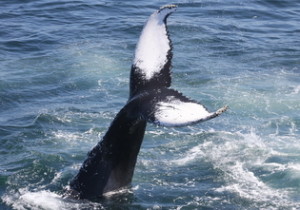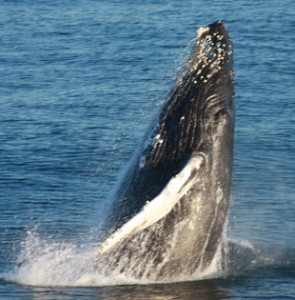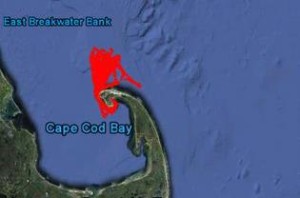August 6 to August 12
On the first trip of August 6th, we headed north and found ourselves on a whale watch that we won’t soon forget! Just to the east of Stellwagen Bank, we located 10-15 feeding humpback whales, including Compass, Putter, Salt, Pivot, and Fracture. In general, humpbacks in the Gulf of Maine will blow clouds of bubbles or kick feed to capture large schools of fish; however, today, their feeding style was quite different. They burst out of the water on their sides, their mouths open and rorqual pleats extended. Soon, we figured out what had changed–they were feeding on krill!
In the photos below, notice how the flexible pleats on the underside of the whales’ bodies stretch as their lower jaws fill with food and water. These ventral pleats allow humpbacks to take in hundreds of gallons with every mouthful.
Krill are a type of small, shrimp-like crustacean, also known as euphausiids. They are often bright red or pink in color, making patches of them quite visible to the naked eye.
At one point, our first mate dipped a bucket off the stern of the Dolphin IX, and pulled up thousands of these bug-eyed crustaceans! A sea full of krill meant that we got to witness a feeding style rarely seen in this area. Even after a summer of excellent feeding displays, we don’t think we’ll be able to top this day!
On August 7, high winds from the northwest made for a bumpy, salty ride out to Stellwagen. Luckily, the whales made our efforts worth the trip. We didn’t have to go far offshore before we saw a breaching Minke whale right off of Wood End. Stormy seas seem to send these normally elusive whales into a frenzy, and this Minke whale continued to breach even as we continued onward towards Stellwagen Bank.
Once we left Cape Cod Bay, we located a humpback named Ember, who was wildly breaching and flipper slapping. This 29 year old male was hard to keep track of, especially with the increasingly rough seas, and we never knew where he would pop up next. At one point, Ember executed a huge breach just off our port bow–about as close to the boat as we had ever seen a whale jump!
Meanwhile, on the Dolphin IX, Bolide’s calf was the one providing all of the aerial excitement. This little guy breached repeatedly while its mother went on long dives, popping up nearby every so often.
We woke up on August 8th to what Cape Codders know as pea soup fog. We were barely out of the harbor when we lost sight of the Pilgrim Monument in Provincetown, and we hoped that by heading to the same spot where whales were seen in previous days that we would be able to at least catch a glimpse of a humpback whale. Once we reached the triangle, an area east of Stellwagen Bank, we stopped to listen. Suddenly, there was a loud exhalation and the acidic smell of whale breath wafting over the bow! A single humpback appeared and seemed to be booking it solidly to the northwest. We attempted to keep up by listening for its breaths, and soon found that several humpbacks seemed to be traveling in the same direction. We soon found out why. As soon as the whales stopped, they began to feed, at times popping up right under the bowsprit with huge mouthfuls of food.
We laughed as we could hear the nasal trumpeting of a whale named Dome. For unknown reasons, Dome, a female humpback first seen in 1986, seems to bellow with every exhalation. Even though we never saw her distinctive flukes in the fog, we knew she was there!
After patchy fog in the afternoon, the evening’s trips were clear and calm, with as many as 35 humpbacks having joined the feeding frenzy.
Not to be ignored were the birds, who were a key part of the action. We watched Roseate Terns, which are an endangered species, make elegant dives after the sand lance that the humpbacks had pushed to the surface with their bubble nets. At one point, a parasite jaeger was seen harassing a tern until it dropped its food. This behavior is known as kleptoparasitism and is typical of these larger seagoing birds.
The southeast corner of Stellwagen Bank was the place to be on August 9. The whales were everywhere, and, as always, we were thrilled to see Salt, a humpback whale who has been making yearly appearances on Stellwagen Bank since 1975. Salt was traveling with another old female, Cardhu, with whom she has been spotted with many times over the years. While humpback whale social associations are temporary and variable, there do seem to be some patterns as to who is seen with whom. For example, older humpbacks are more likely to be found in groups than juveniles. Speaking of association patterns, we were astounded to see that a rather large, persistent group from last season seems to have re-formed. Last year, Cajun, Perseid and their respective calves were seen for several months straight associating with Pele, Jabiru, and Milkweed. After a round-trip migration of over 6,000 miles, these whales have relocated one another in the feeding grounds for a second year in a row!
Meanwhile, aboard the Dolphin VIII, Dracula was the star of the morning’s trip. Dracula was first seen in 1990 and was originally thought to be a male — that is until she arrived in Stellwagen Bank in 1996 with a calf in tow. Today, this whale was rolling on her back and flipper slapping for at least 15 minutes!
On the morning of August 10th, it was rainy and foggy on land, but once we got offshore the whales made up for the less than stellar weather. Once we got to the southeast corner of Stellwagen Bank, there were whales all over the place. We counted at least 30 different humpback whales, including Aerospace, Draco, Bounce, Pixar, Infinity and Putter. Putter was the most active whale of the morning. While one humpback rolled on its side, flipper slapping, Putter chin breached repeatedly.
The sun was out by the afternoon trip, and we began our early afternoon trip aboard the Dolphin VIII with triple lobtails from Eruption, Bolide and Bolide’s calf. The calf seemed to mimic Eruption as she rolled on her side and slapped her flippers. The calf followed suit as mom followed close behind.
Passengers aboard the Dolphin VIII had a great time watching Pumpkinseed lobtailing repeatedly. Pumpkinseed was first seen as an adult and we are not sure whether this whale is a male or female. Without genetic evidence or documentation of a humpback with a calf, determining gender is often difficult. Photos of the underside of the whale’s body, often obtainable when the whale is lobtailing, can shed light on the sex of a humpback.
We finished off this trip with insane feeding chaos at the southeast corner of Stellwagen Bank. We had a pile of over 60 humpback whales, including Salt, Cajun, Hancock, Pumba, Backgammon, Tear, Polaris and Ampersand. At one point we had 12 adult humpbacks, plus one calf emerging through the same bubble net!
Putter was at it again on August 11th, this time as part of a huge group of feeding humpback whales. Dolphin Fleet naturalists exclaimed that this was one of the most exciting displays they had seen (although this type of pronouncement seemed to be a trend this week)!
A mixed group of humpbacks and minkes fed right next to the boat. While these two species of baleen whales generally feed on the same small fish, it is nonetheless rare to see them feeding in such close concert to one another. The humpback feeding frenzy peaked in mid-day, with Firefly, Pogo, Spike, Backgammon, Exclaim, Firefly, Ember, Tracer and Rattan among the whales working together to assemble huge nets of bubbles through which they would lunge with wide-open mouths.
We watched with interest as Canopy’s calf, now only a few months old, appeared to imitate the adults in the pack by practicing quick lunges at the surface. Though it is most likely still feeding on its mother’s milk, this little calf will need to learn how to feed on solid food in the next few months, so it is in good company learning to corral these large schools of fish.
Like the whales, the birds are important part of our ecosystem, and today was also an amazing day of birding! A birder on board the Dolphin VIII noticed a few Ruddy Turnstones perched atop the breakwater as we left Provincetown Harbor. Further offshore, we had great looks at Great and Sooty Shearwaters all day, as well as many Cory’s Shearwaters in the morning with more Manx Shearwaters making appearances later in the day. We also had a few immature gannets on each trip. We started to notice an increasing number of terns offshore as more and more fledlings leave the nest. The terns are mostly common terns, but a more trilling call gave away the presence of some Roseate terns as well. In addition, we had spectacular looks at Pomarine jaegers on the afternoon trip. Mostly the pomarines were after the food of immature laughing gulls, who, in turn, were constantly after the terns hoping to get them to drop their prey!
Throughout the afternoon and evening, the whales calmed down, and were largely lazing around and diving deep. Humpbacks were spread out across the southeast corner, and groups were joining and splitting rapidly. Alphorn, for instance, went from logging side by side with Circuit to breaching simultaneously with a second, unidentified humpback!
August 12th was a clear, crisp, day, with the northwest wind making it feel an awful lot like fall was in the air. It was so clear that we could see the smokestack by the Sagamore Bridge all the way across the bay. Overall, it was a quiet day on the water, with a lot of low-key humpbacks spread out across the southeastern edge of Stellwagen Bank. We did have a few bursts of excitement from Pivot, a young whale first seen in 2008, who lobtailed repeatedly.
This week wouldn’t be complete without a good breach! Though it is normally a rare sight to see one of these huge beasts hurl themselves out of the water, the unsettled seas this week riled up our humpbacks, making breaching something that was seen on nearly every trip!
At the end of this week we also received the first round of results from the Gulf of Maine Humpback tagging project headed by the Provincetown Center for Coastal Studies, the National Marine Mammal Laboratory, and other partners. In this pilot project, scientists are investigating the health effects and longevity of a new type of tag for humpback whales. In the past, tagging projects have been problematic because whales’ bodies tend to rapidly reject tags that have been embedded in their skin, making long term studies very challenging. Scientists are currently assessing the effectiveness of a new type of tag by looking at 15 different tagged humpbacks in the Stellwagen Bank area. These humpbacks were tagged in mid-July and preliminary results are allowing scientists to track humpback whale movements throughout the southern Gulf of Maine. To see some of these tracks, visit the following site.
Here’s where we went this week:







